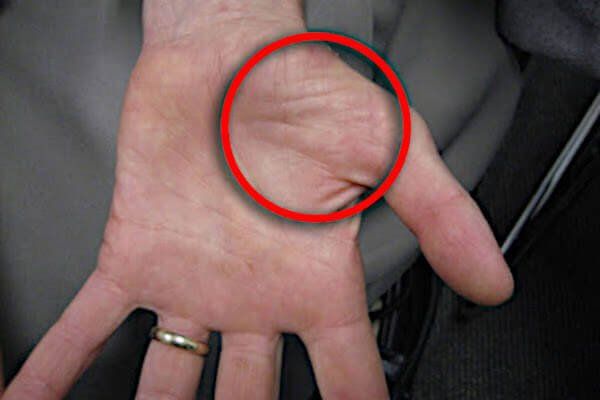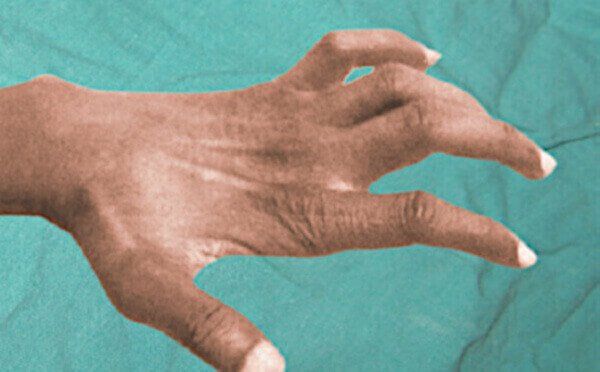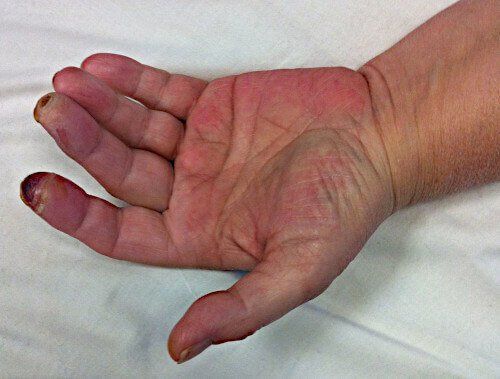What Extreme or Severe Carpal Tunnel Syndrome Feels Like
If
mild carpal tunnel is like having a splinter, then
severe carpal tunnel syndrome is like having a broken leg that's on fire. There's a tremendous difference between the mild and severe stages. But the in-between or "moderate stage" is by far the most common. It also can last the longest (sometimes more than
2 years).
Table of Contents
- Signs of severe carpal tunnel syndrome
- 4 Criteria for having severe carpal tunnel syndrome
- Signs that severe carpal tunnel syndrome has begun
- "End stage" carpal tunnel syndrome
- How to treat severe carpal tunnel syndrome
- Surgery
- Surgery's success rate
- Non-surgical
- Night bracing
- Rest & avoidance
- Hand/Finger Stretching Exercises
- Myofascial release massage
- Conclusions
As carpal tunnel progresses to the severe stage, your symptoms will escalate from an occasional discomfort to being constant and "cruel or punishing". Usually this advancement occurs in less than one year. Additionally, other symptoms (like weakness and dexterity problems) very likely will appear as the disorder progresses.
Also with severe carpal tunnel syndrome, it's common to feel pain radiate or "shoot" up the arm - often described as shooting electric shocks. The forearm may even feel tender almost up to the elbow. In rarer cases, pain or tenderness can travel past the elbow, up the arm, and into the shoulder.
Most patients in the severe stage have catastrophic loss of finger dexterity and grip strength. They tend to drop things like frying pans, beverage bottles, and drinking glasses. Many find it impossible to perform simple tasks like opening a jar, picking up coins, buttoning a shirt, tying a shoelace or writing with a pen. The strength to turn a doorknob or open a car door is diminished.
Personal grooming, toileting, washing, and dressing become a real chore. Folding clothes or linens is nearly impossible. Many parents must give up lifting their infant for fear of dropping the child. Severe carpal tunnel interferes with every moment of your life.
Signs of severe carpal tunnel syndrome
It's important to note that the mild, moderate, and severe carpal tunnel syndrome stages have nearly identical symptoms. But the
intensity
of each symptom increases dramatically with increasing severity.
The most common symptoms of severe carpal tunnel syndrome include one or more of the following:
4 Criteria for having severe carpal tunnel syndrome
Doctors and therapists usually describe your carpal tunnel as “severe stage” when 4 clinical criteria are met:
- The intensity of symptoms is maximal, and interferes with every aspect of your life.
- Symptoms are mostly constant.
- There's considerable loss of function (i.e., clumsiness, loss of finger dexterity, and diminished
hand strength).
- You have reduced sensation to hot and cold temperatures.
If you are not in the severe stage yet, consider yourself lucky. You have many options available to relieve carpal tunnel symptoms right now.
And if you're in the severe stage now, there are still therapies which work very effectively. One therapy is
surgery. The other is a combination of
non-surgical remedies which work as well or better than surgery. These therapies are described below.
None of these therapies (surgical or non-surgical) may ever get your hands back to feeling 18 years old again. But they usually can make your daily life a hundred times better.
Signs that severe carpal tunnel syndrome has begun
Certain signs tell you that carpal tunnel has progressed from the moderate stage to the severe stage. By now, most patients have decided to get help rather than ignore these symptoms.
The main signs of severe carpal tunnel syndrome are:
- Pain, numbness or tingling are maximally intense.
- Symptoms are (nearly) constant.
- You cannot do anything with your hand normally (without having to make adjustments).
- You cannot go longer than a few minutes without being distracted by your numbness or pain.
One of the most common statements
severe stage patients make to therapists and doctors is,
"I want to cut my hand off!"
Usually, the quality and intensity of carpal tunnel symptoms change with advancement of the disorder. Any one or more of the following may occur in one or more or your fingers (not your pinky finger) and palm of your hand:
- Burning, tenderness, and soreness may or may not intensify. That's because these sensation are often masked by the overall pain.
- Feelings of puffiness or swelling may intensify.
- Shooting electric shocks are more frequent, more easily triggered, and may radiate up your arm.
- Hand clumsiness and weakness will dominate how you perform tasks.
In rare cases, some of these symptoms can be felt radiating to (or beyond) the elbow. Rarer still, symptoms (usually pain) can enter your upper arm and shoulder.
Loss of hand and finger function is catastrophic in the severe stage. That's because there's severe loss of grip strength and dexterity. Patients tend to drop things like cooking pots, beverage cups, bottles, even infants. Opening a car or house door, picking up coins, opening a jar, buttoning a shirt, hand writing, typing, or tying shoelaces is nearly impossible. Carrying anything over a few pounds will probably result in dropping it.
Not being able to use your hands normally poses significant problems with activities of daily living. Patients have great difficulty with feeding themselves, personal grooming, dressing, toileting, washing, and general hygiene.
"End stage" carpal tunnel syndrome
Just when you thought carpal tunnel couldn't get any worse, it does. After the severe stage, doctors call the terminal phase of the disorder
"end stage"
carpal tunnel syndrome.
The end stage means, since there was no attempt at intervention, the disorder progressed to its final, catastrophic phase. This stage is not reversible with any known therapy (surgery and non-surgical remedies have no effect).
The flattening out of the thenar eminence (thumb muscle atrophy) is the first clue you have end stage carpal tunnel syndrome. Combined with the inability to use your thumb, and you can be sure that your median nerve is effectively dead.
Another characteristic of end stage carpal tunnel syndrome is the appearance of a "claw hand". Eventually, you fingers are in a perpetual claw position due to lack of flexor tendon function (see image above).
A dangerous result of end stage carpal tunnel syndrome is losing the ability to feel hot and cold temperatures. It's common for these patients to burn themselves while cooking at the stove (see image above). Many say they didn't know there was a problem until they smelled flesh burning.
Interestingly, with end stage carpal tunnel syndrome, many patients see their
pain
diminish. However, the punishing numbness remains.
The sad thing is that up until the end stage, most patients had a choice about stopping carpal tunnel in its tracks. There were a variety of treatments to choose from that would have reduced or even eliminated symptoms.
Even with severe carpal tunnel syndrome, surgical and nonsurgical remedies are available (see below).
But as the median nerve is dead during the end stage, there is nothing that can be done. Most
carpal tunnel doctors will refuse to perform surgery on end stage patients because of the inevitable failure of surgery.
How to treat severe carpal tunnel syndrome
Usually, most stages of carpal tunnel syndrome can be successfully
treated. This is not true of the end stage. Moreover, the less severe the disorder, the higher the success rate of the treatment.
The
most successful remedies focus on relieving pressure on the median nerve. Essentially, there are 2 such treatment methods for carpal tunnel syndrome:
When it comes to choosing which method is best for your severe carpal tunnel syndrome, doctors, therapists, and patients consider 3 factors:
- How intense your symptoms are: less intense symptoms should be treated non-surgically. More severe symptoms can be treated surgically or non-surgically.
- How long have you've had intense symptoms:
intense symptoms less than 6 months old should be treated non-surgically. Symptoms over 6 months old
can be treated surgically or non-surgically.
- Have you tried treating on your own:
if you tried every (medically approved) non-surgical remedy available, then surgery is your only available option.
Surgery (called "carpal tunnel release surgery")
Surgery's success rate
The generally accepted success rate of carpal tunnel release surgery is
50 - 70% of "moderate-to-severe symptoms". This is based on a number of effectiveness measurements. It is irrespective of the surgical method used.
When it comes to measuring "patient satisfaction" with carpal tunnel surgery, approximately
50% success is reported. The primary reason for surgical failure or dissatisfaction is
persistent symptoms
and return of symptoms by the second year.
Non-surgical
The
American Academy of Orthopedic Surgeons as well as the
National Institutes of Health
advise having carpal tunnel release surgery
only after
trying all non-surgical methods first. That's because, unlike surgery, there is no disadvantage to trying non-surgical therapies before having a hand operation.
Non-surgical remedies work in the
vast majority
of patients with moderate and moderate-to-severe carpal tunnel syndrome. The non-surgical remedies recommended by doctors must be performed
simultaneously to obtain good results. In other words, just one remedy alone (like night bracing) will not be sufficient to eliminate symptoms of severe carpal tunnel syndrome.
Studies show that the success rate of using the non-surgical approach is at least
equivalent to
carpal tunnel release
surgery. In
most patients with moderate severity, non-surgical treatments are even better than surgery.
These 4 combined remedies consist of:
- Night Bracing
- Rest & Avoidance
- Hand/Finger Stretching Exercises
- Myofascial Release Massage
Night bracing
Rest & avoidance
Hand/finger stretching exercises
Myofascial release massage
Conclusions
If you have severe carpal tunnel syndrome then it's likely you've gone without proper treatment for some time. Unfortunately, this is a progressive disorder. That means the more advanced your symptoms, the more difficult it is to get good remission of those symptoms. By the time you reach the severe stage, you have two options available to eliminate (or greatly reduce) symptoms. They are surgical and non-surgical remedies. Carpal tunnel release surgery (using either the endoscopic or open release techniques) has about a 50% chance of providing good results. Non-surgical remedies consist of night bracing, rest & avoidance, stretching exercises, and myofascial release massage. The result of using all of these techniques simultaneously is as good, and often better, than surgery.
About














